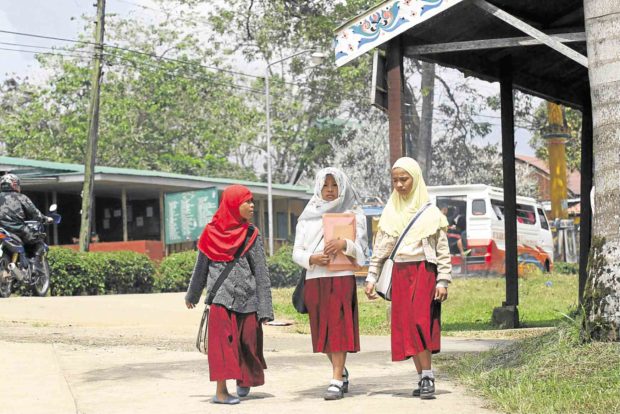Senate seeks purge of ‘ghost’ students

Students in the Autonomous Region in Muslim Mindanao suffer as some public school officials misuse government funds intended for education in the region. —JEOFFREY MAITEM
CAGAYAN DE ORO CITY — Sen. Juan Miguel Zubiri has proposed an overhaul of the system in which funds are released to public schools to prevent the proliferation of “ghost” students, like those uncovered in the Autonomous Region in Muslim Mindanao (ARMM).
Zubiri made the proposal following reports submitted to the Senate committee on finance that at least 207,884 ghost students were in the records of ARMM public schools from 2011 to 2016.
“A number of principals, [education] supervisors and teachers have been padding the rolls of students to get a bigger budget based on fake and inflated number of students,” Zubiri said.
He said the racket had been going on in ARMM for years until it was exposed by Gov. Mujiv Hataman when he assumed office in 2012.
The Senate report said the padding was done by some school officials, teachers and their partners in some government agencies.
Article continues after this advertisement“We have to change the system in the budgeting of public schools,” Zubiri said, but without discussing how this would be implemented.
Article continues after this advertisementHe said the web of corruption in the educational system, including the proliferation of ghost students in public schools, had been causing extreme poverty in Mindanao.
“We have uncovered that this [has] been happening for many decades especially in rebel- and terrorist-infested areas,” Zubiri said.
Hataman said ARMM had been trying its best to purge ghost students from the school rosters in the provinces of Lanao del Sur, Maguindanao, Tawi-Tawi, Sulu and Basilan through a system that would confirm their identities and log in important information into a databank.
He said that among the measures the region had adopted to stop the padding of student rosters in public schools was the implementation of the Learners’ Reference Number (LRN), which is distinct to each pupil and which matches with information stored in a databank called Learners’ Information System.
He said LRN was similar to the permanent student number being used by the University of the Philippines System, which included “extensive information” on each student stored in a database.
Hataman, in a text message, said he informed the senators that the problem about ghost students and ghost teachers in the region was serious and widespread.
“If I start filing cases against school heads and principals (involved in the scheme), in Lanao del Sur (for example), I am afraid (that) there will be no more principals (who will be) left. Or if there will be, just a few of them will remain,” Hataman said.
In 2013 alone, his office had purged close to 80,000 students from the rolls and 40 ghost teachers from the payroll.
The purging of nonexistent students reduced the region’s student population of 785,267 by more than 10 percent in 2013 alone, Hataman said.
He said his office sued several people involved in the irregularity. He, however, did not name them. —With a report from Julie Alipala